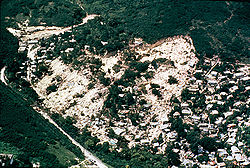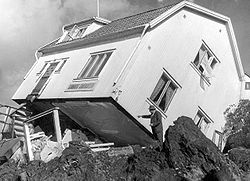Landslide

A landslide includes a wide range of ground movements, such as rock falls, deep failure of slopes and shallow debris flows.
The biggest reason for a landslide is that there is a slope and material goes down the slope because of gravity.
But other things also contribute to landslides:
- erosion by rivers, glaciers, or ocean waves makes slopes too steep
- rock and soil slopes made weak through saturation by snowmelt or heavy rains
- earthquakes that make weak slopes fail or crack the rocks that will eventually fall down
- volcanic eruptions produce loose ash deposits, heavy rain, and debris flows
- vibrations from machinery, traffic, blasting and even thunder may trigger failure of weak slopes
- weight from much rain or snow, stockpiling of rock or ore, from waste piles, or from buildings may stress weak slopes to failure and other structures
- groundwater pressure making the slope unstable
- in shallow soils, the removal of deep-rooted plants that bind the colluvium to bedrock
An underlying reason is the nature of the material. For example, a thixotropic material such as mud or sand and water, can change from a gel to a sol by adding water or pressure, or shaking. It goes from being stable one minute to fluid the next minute. The greatest disasters, like lahars or mudslides, happen suddenly. It is possible for much of a volcano to just slide down suddenly, as with Toba, Krakatoa and Mount St Helens.
Landslide Media
A landslide near Cusco, Peru, in 2018
A NASA model has been developed to look at how potential landslide activity is changing around the world.
Animation of a landslide in San Mateo County, California
Noire River (Rivière Noire), Saint-Alban landslide 1894, Quebec, Canada
The Mameyes Landslide, in the Mameyes neighborhood of barrio Portugués Urbano in Ponce, Puerto Rico, was caused by extensive accumulation of rains and, according to some sources, lightning. It buried more than 100 homes.
The landslide at Surte in Sweden, 1950. It was a quick clay slide that killed one person.
The Costa della Gaveta earthflow in Potenza, Italy. Even though it moves at a rate of just a few millimeters per year and is hardly visible, this landslide causes progressive damage to the national road, the national highway, a flyover, and several houses that are built on it.
A rock slide in Guerrero, Mexico
Other websites
| Wikimedia Commons has media related to Lua error in Module:Commons_link at line 62: attempt to index field 'wikibase' (a nil value).. |
- United States Geological Survey site
- British Columbia government landslide information Archived 2008-06-12 at the Wayback Machine
- Slide! Archived 2009-04-30 at the Wayback Machine, a program on B.C.'s Knowledge Network, with video clips
- Geoscience Australia Fact Sheet Archived 2007-10-16 at the Wayback Machine








